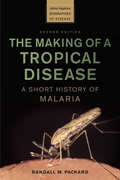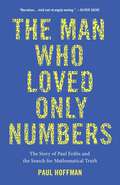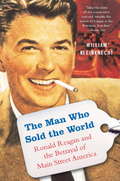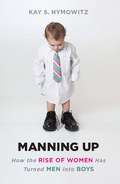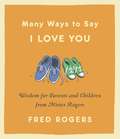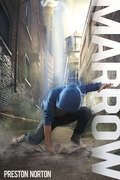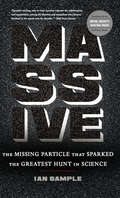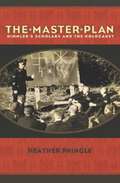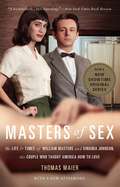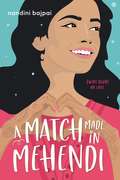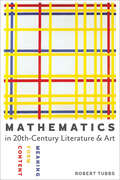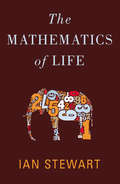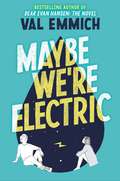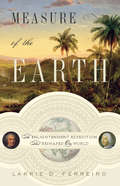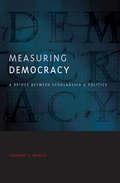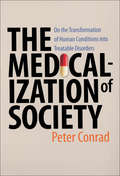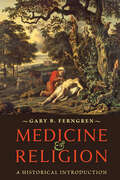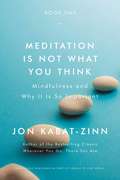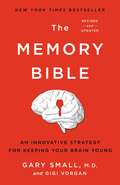- Table View
- List View
The Making of a Tropical Disease: A Short History of Malaria (Johns Hopkins Biographies of Disease)
by Randall M. PackardA global history of malaria that traces the natural and social forces that have shaped its spread and made it deadly, while limiting efforts to eliminate it.Malaria sickens hundreds of millions of people—and kills nearly a half a million—each year. Despite massive efforts to eradicate the disease, it remains a major public health problem in poorer tropical regions. But malaria has not always been concentrated in tropical areas. How did malaria disappear from other regions, and why does it persist in the tropics? From Russia to Bengal to Palm Beach, Randall M. Packard's far-ranging narrative shows how the history of malaria has been driven by the interplay of social, biological, economic, and environmental forces. The shifting alignment of these forces has largely determined the social and geographical distribution of the disease, including its initial global expansion, its subsequent retreat to the tropics, and its current persistence. Packard argues that efforts to control and eliminate malaria have often ignored this reality, relying on the use of biotechnologies to fight the disease. Failure to address the forces driving malaria transmission have undermined past control efforts.Describing major changes in both the epidemiology of malaria and efforts to control the disease, the revised edition of this acclaimed history, which was chosen as the 2008 End Malaria Awards Book of the Year in its original printing,• examines recent efforts to eradicate malaria following massive increases in funding and political commitment; • discusses the development of new malaria-fighting biotechnologies, including long-lasting insecticide-treated nets, rapid diagnostic tests, combination artemisinin therapies, and genetically modified mosquitoes; • explores the efficacy of newly developed vaccines; and • explains why eliminating malaria will also require addressing the social forces that drive the disease and building health infrastructures that can identify and treat the last cases of malaria.Authoritative, fascinating, and eye-opening, this short history of malaria concludes with policy recommendations for improving control strategies and saving lives.
The Making of a Tropical Disease: A Short History of Malaria (Johns Hopkins Biographies of Disease)
by Randall M. PackardA global history of malaria that traces the natural and social forces that have shaped its spread and made it deadly, while limiting efforts to eliminate it.Malaria sickens hundreds of millions of people—and kills nearly a half a million—each year. Despite massive efforts to eradicate the disease, it remains a major public health problem in poorer tropical regions. But malaria has not always been concentrated in tropical areas. How did malaria disappear from other regions, and why does it persist in the tropics? From Russia to Bengal to Palm Beach, Randall M. Packard's far-ranging narrative shows how the history of malaria has been driven by the interplay of social, biological, economic, and environmental forces. The shifting alignment of these forces has largely determined the social and geographical distribution of the disease, including its initial global expansion, its subsequent retreat to the tropics, and its current persistence. Packard argues that efforts to control and eliminate malaria have often ignored this reality, relying on the use of biotechnologies to fight the disease. Failure to address the forces driving malaria transmission have undermined past control efforts.Describing major changes in both the epidemiology of malaria and efforts to control the disease, the revised edition of this acclaimed history, which was chosen as the 2008 End Malaria Awards Book of the Year in its original printing,• examines recent efforts to eradicate malaria following massive increases in funding and political commitment; • discusses the development of new malaria-fighting biotechnologies, including long-lasting insecticide-treated nets, rapid diagnostic tests, combination artemisinin therapies, and genetically modified mosquitoes; • explores the efficacy of newly developed vaccines; and • explains why eliminating malaria will also require addressing the social forces that drive the disease and building health infrastructures that can identify and treat the last cases of malaria.Authoritative, fascinating, and eye-opening, this short history of malaria concludes with policy recommendations for improving control strategies and saving lives.
The Man Who Loved Only Numbers: The Story of Paul Erdos and the Search for Mathematical Truth
by Paul Hoffman"A funny, marvelously readable portrait of one of the most brilliant and eccentric men in history." --The Seattle Times Paul Erdos was an amazing and prolific mathematician whose life as a world-wandering numerical nomad was legendary. He published almost 1500 scholarly papers before his death in 1996, and he probably thought more about math problems than anyone in history. Like a traveling salesman offering his thoughts as wares, Erdos would show up on the doorstep of one mathematician or another and announce, "My brain is open." After working through a problem, he'd move on to the next place, the next solution. Hoffman's book, like Sylvia Nasar's biography of John Nash, A Beautiful Mind, reveals a genius's life that transcended the merely quirky. But Erdos's brand of madness was joyful, unlike Nash's despairing schizophrenia. Erdos never tried to dilute his obsessive passion for numbers with ordinary emotional interactions, thus avoiding hurting the people around him, as Nash did. Oliver Sacks writes of Erdos: "A mathematical genius of the first order, Paul Erdos was totally obsessed with his subject--he thought and wrote mathematics for nineteen hours a day until the day he died. He traveled constantly, living out of a plastic bag, and had no interest in food, sex, companionship, art--all that is usually indispensable to a human life."The Man Who Loved Only Numbers is easy to love, despite his strangeness. It's hard not to have affection for someone who referred to children as "epsilons," from the Greek letter used to represent small quantities in mathematics; a man whose epitaph for himself read, "Finally I am becoming stupider no more"; and whose only really necessary tool to do his work was a quiet and open mind. Hoffman, who followed and spoke with Erdos over the last 10 years of his life, introduces us to an undeniably odd, yet pure and joyful, man who loved numbers more than he loved God--whom he referred to as SF, for Supreme Fascist. He was often misunderstood, and he certainly annoyed people sometimes, but Paul Erdos is no doubt missed. --Therese Littleton
The Man Who Sold the World: Ronald Reagan and the Betrayal of Main Street America
by William KleinknechtSince Ronald Reagan left office-and particularly after his death-his shadow has loomed large over American politics: Republicans and many Democrats have waxed nostalgic, extolling the Republican tradition he embodied, the optimism he espoused, and his abilities as a communicator.This carefully calibrated image is complete fiction, argues award-winning journalist William Kleinknecht. The Reagan presidency was epoch shattering, but not-as his propagandists would have it-because it invigorated private enterprise or made America feel strong again. His real legacy was the dismantling of an eight-decade period of reform in which working people were given an unprecedented sway over our politics, our economy, and our culture. Reagan halted this almost overnight.In the tradition of Thomas Frank's What's the Matter with Kansas?, Kleinknecht explores middle America-starting with Reagan's hometown of Dixon, Illinois-and shows that as the Reagan legend grows, his true legacy continues to decimate middle America.
The Man Who Sold the World: Ronald Reagan and the Betrayal of Main Street America
by William KleinknechtSince Ronald Reagan left office -- and particularly after his death -- his shadow has loomed large over American politics: Republicans and many Democrats have waxed nostalgic, extolling the Republican tradition he embodied, the optimism he espoused, and his abilities as a communicator. This carefully calibrated image is complete fiction, argues award-winning journalist William Kleinknecht. The Reagan presidency was epoch shattering, but not -- as his propagandists would have it -- because it invigorated private enterprise or made America feel strong again. His real legacy was the dismantling of an eight-decade period of reform in which working people were given an unprecedented sway over our politics, our economy, and our culture. Reagan halted this almost overnight. In the tradition of Thomas Frank's What's the Matter with Kansas?, Kleinknecht explores middle America -- starting with Reagan's hometown of Dixon, Illinois -- and shows that as the Reagan legend grows, his true legacy continues to decimate middle America.
Managerial Accounting
by Kurt Heisinger Joe HoyleKurt Heisinger and Joe Ben Hoyle believe that students want to learn accounting in the most efficient way possible, balancing coursework with personal schedules. They tend to focus on their studies in short intense segments between jobs, classes, and family commitments. Meanwhile, the accounting industry has endured dramatic shifts since the collapse of Enron and WorldCom, causing a renewed focus on ethical behavior in accounting. This dynamic author team designed Managerial Accounting to work within the confines of today’s students’ lives while delivering a modern look at managerial accounting. Managerial Accounting was written around three major themes: Ready, Reinforcement and Relevance. This book is aimed squarely at the new learning styles evident with today’s students and addresses accounting industry changes as well.
Manning Up: How the Rise of Women Has Turned Men into Boys
by Kay S. HymowitzIn Manning Up, Manhattan Institute fellow and City Journal contributing editor Kay Hymowitz argues that the gains of the feminist revolution have had a dramatic, unanticipated effect on the current generation of young men. Traditional roles of family man and provider have been turned upside down as "pre-adult” men, stuck between adolescence and "real” adulthood, find themselves lost in a world where women make more money, are more educated, and are less likely to want to settle down and build a family. Their old scripts are gone, and young men find themselves adrift. Unlike women, they have no biological clock telling them it's time to grow up. Hymowitz argues that it's time for these young men to "man up.”
Many Ways to Say I Love You: Wisdom for Parents and Children from Mister Rogers
by Fred RogersInspirational words on parenting from the beloved PBS series Mister Rogers' Neighborhood, for new parents and those whose children are grown.Fred Rogers has long been a wonderful resource for parents, offering their children entertainment and education through his enduring television show. Now his special brand of good cheer and wisdom are brought together especially for parents in this newest book based on never-before-published works.Many Ways to Say I Love You is a treasury of segments from speeches and observations from his years of working with parents and children, as well as other materials from books, songs, TV commentary, and more. Using stories from his own life, Mister Rogers discusses the importance of children and the role of parents.
Many Ways to Say I Love You: Wisdom for Parents and Children from Mister Rogers
by Fred RogersInspirational words on parenting from the beloved PBS series Mister Rogers' Neighborhood, for new parents and those whose children are grown. Fred Rogers has long been a wonderful resource for parents, offering their children entertainment and education through his enduring television show. Now his special brand of good cheer and wisdom are brought together especially for parents in this newest book based on never-before-published works.Many Ways to Say I Love You is a treasury of segments from speeches and observations from his years of working with parents and children, as well as other materials from books, songs, TV commentary, and more. Using stories from his own life, Mister Rogers discusses the importance of children and the role of parents.
Marrow
by Preston NortonPreston Norton&’s bestselling and award-winning Marrow grabs readers and doesn&’t let go until they enroll in the Fantom Institute for Superheroes-in-Training themselves.
Massive: The Missing Particle That Sparked the Greatest Hunt in Science
by Ian SampleThe biggest science story of our time, Massive spans four decades, weaving together the personal narratives and international rivalries behind the search for the "God" particle, or Higgs boson. A story of grand ambition, intense competition, clashing egos, and occasionally spectacular failures, Massive is the first book that reveals the science, culture, and politics behind the biggest unanswered question in modern physics-what gives things mass? Drawing upon his unprecedented access to Peter Higgs, after whom the particle is named, award-winning science writer Ian Sample chronicles the multinational and multibillion-dollar quest to solve the mystery of mass. For scientists, to find the God particle is to finally understand the origin of mass, and until now, the story of their search has never been told.
The Master Plan: Himmler's Scholars and the Holocaust
by Heather PringleA groundbreaking history of the Nazi research institute whose work helped lead to the extermination of millionsIn 1935, Heinrich Himmler established a Nazi research institute called The Ahnenerbe, whose mission was to send teams of scholars around the world to search for proof of Ancient Aryan conquests. But history was not their most important focus. Rather, the Ahnenerbe was an essential part of Himmler's master plan for the Final Solution. The findings of the institute were used to convince armies of SS men that they were entitled to slaughter Jews and other groups. And Himmler also hoped to use the research as a blueprint for the breeding of a new Europe in a racially purer mold.The Master Plan is a groundbreaking exposé of the work of German scientists and scholars who allowed their research to be warped to justify extermination, and who directly participated in the slaughter--many of whom resumed their academic positions at war's end. It is based on Heather Pringle's extensive original research, including previously ignored archival material and unpublished photographs, and interviews with living members of the institute and their survivors.A sweeping history told with the drama of fiction, The Master Plan is at once horrifying, transfixing, and monumentally important to our comprehension of how something as unimaginable as the Holocaust could have progressed from fantasy to reality.
Masters of Sex: The Life and Times of William Masters and Virginia Johnson, the Couple Who Taught America How to Love
by Thomas MaierNow a New Showtime Original SeriesShowtime's dramatic series Masters of Sex, starring Michael Sheen and Lizzy Caplan, is based on this real-life story of sex researchers William Masters and Virginia Johnson. Before Sex and the City and ViagraTM, America relied on Masters and Johnson to teach us everything we needed to know about what goes on in the bedroom. Convincing hundreds of men and women to shed their clothes and copulate, the pair were the nation’s top experts on love and intimacy. Highlighting interviews with the notoriously private Masters and the ambitious Johnson, critically acclaimed biographer Thomas Maier shows how this unusual team changed the way we all thought about, talked about, and engaged in sex while they simultaneously tried to make sense of their own relationship. Entertaining, revealing, and beautifully told, Masters of Sex sheds light on the eternal mysteries of desire, intimacy, and the American psyche.
A Match Made in Mehendi
by Nandini BajpaiFor fans of Brandy Colbert and Jenny Han comes a lighthearted novel about tradition, high school social hierarchy, matchmaking, and swiping right (or left!) Fifteen-year-old Simran "Simi" Sangha comes from a long line of Indian vichole -- matchmakers -- with a rich history for helping parents find good matches for their grown children. When Simi accidentally sets up her cousin and a soon-to-be lawyer, her family is thrilled that she has the "gift."But Simi is an artist, and she doesn't want to have anything to do with relationships, helicopter parents, and family drama. That is, until she realizes this might be just the thing to improve her and her best friend Noah's social status. Armed with her family's ancient guide to finding love, Simi starts a matchmaking service -- via an app, of course.But when she helps connect a wallflower of a girl with the star of the boys' soccer team, she turns the high school hierarchy topsy-turvy, soon making herself public enemy number one.
Math in Society Edition 2.2
by David LippmanMath in Society is a survey of contemporary mathematical topics, appropriate for a college-level topics course for liberal arts major, or as a general quantitative reasoning course.
Mathematics in Twentieth-Century Literature and Art: Content, Form, Meaning
by Robert TubbsDuring the twentieth century, many artists and writers turned to abstract mathematical ideas to help them realize their aesthetic ambitions. Man Ray, Marcel Duchamp, and, perhaps most famously, Piet Mondrian used principles of mathematics in their work. Was it mere coincidence, or were these artists simply following their instincts, which in turn were ruled by mathematical underpinnings, such as optimal solutions for filling a space? If math exists within visual art, can it be found within literary pursuits? In short, just what is the relationship between mathematics and the creative arts?In this provocative, original exploration of mathematical ideas in art and literature, Robert Tubbs argues that the links are much stronger than previously imagined and exceed both coincidence and commonality of purpose. Not only does he argue that mathematical ideas guided the aesthetic visions of many twentieth-century artists and writers, Tubbs further asserts that artists and writers used math in their creative processes even though they seemed to have no affinity for mathematical thinking. In the end, Tubbs makes the case that art can be better appreciated when the math that inspired it is better understood. An insightful tour of the great masters of the last century and an argument that challenges long-held paradigms, Mathematics in Twentieth-Century Literature and Art will appeal to mathematicians, humanists, and artists, as well as instructors teaching the connections among math, literature, and art.
The Mathematics of Life: Unlocking The Secrets Of Existence
by Ian Stewart"Will this book do for biomathematics what Stephen Hawking's A Brief History of Time did for relativity and cosmology? Time will tell. Until then, the distinguished author's friendly, well-argued style should guarantee its popular success." --Times Higher Education Supplement (London)Biologists have long dismissed mathematics as being unable to meaningfully contribute to our understanding of living beings. Within the past ten years, however, mathematicians have proven that they hold the key to unlocking the mysteries of our world--and ourselves. In The Mathematics of Life, Ian Stewart provides a fascinating overview of the vital but little-recognized role mathematics has played in pulling back the curtain on the hidden complexities of the natural world--and how its contribution will be even more vital in the years ahead. In his characteristically clear and entertaining fashion, Stewart explains how mathematicians and biologists have come to work together on some of the most difficult scientific problems that the human race has ever tackled, including the nature and origin of life itself.
Maybe We're Electric
by Val EmmichFrom Val Emmich, the bestselling author of Dear Evan Hansen: The Novel, comes a deeply affecting story of two teens who find themselves thrown together overnight during a snowstorm and discover a surprising connection—perfect for fans of Nina LaCour, David Arnold, and Robin Benway.Tegan Everly is quiet. Known around school simply as the girl with the hand, she's usually only her most outspoken self with her friend Neel, and right now they're not exactly talking. When Tegan is ambushed by her mom with a truth she can't face, she flees home in a snowstorm, finding refuge at a forgotten local attraction—the tiny Thomas Edison museum.She's not alone for long. In walks Mac Durant. Striking, magnetic, a gifted athlete, Mac Durant is the classmate adored by all. Tegan can't stand him. Even his name sounds fake. Except the Mac Durant she thinks she knows isn't the one before her now—this Mac is rattled and asking her for help.Over one unforgettable night spent consuming antique records and corner-shop provisions, Tegan and Mac cast aside their public personas and family pressures long enough to forge an unexpectedly charged bond and—in the very spot in New Jersey that inspired Edison's boldest creations—totally reinvent themselves. But could Tegan's most shameful secret destroy what they've built?Emotionally vivid and endlessly charming, Maybe We're Electric is an artfully woven meditation on how pain can connect us—we can carry it alone in darkness or share the burden and watch the world light up again.
Measure of the Earth: The Enlightenment Expedition That Reshaped Our World
by Larrie D. FerreiroIn the early eighteenth century, at the peak of the Enlightenment, an unlikely team of European scientists and naval officers set out on the world&’s first international, cooperative scientific expedition. Intent on making precise astronomical measurements at the Equator, they were poised to resolve one of mankind&’s oldest mysteries: the true shape of the Earth. In Measure of the Earth, award-winning science writer Larrie D. Ferreiro tells the full story of the Geodesic Mission to the Equator for the very first time. It was an age when Europe was torn between two competing conceptions of the world: the followers of René Descartes argued that the Earth was elongated at the poles, even as Isaac Newton contended that it was flattened. A nation that could accurately determine the planet&’s shape could securely navigate its oceans, giving it great military and imperial advantages. Recognizing this, France and Spain organized a joint expedition to colonial Peru, Spain&’s wealthiest kingdom. Armed with the most advanced surveying and astronomical equipment, they would measure a degree of latitude at the Equator, which when compared with other measurements would reveal the shape of the world. But what seemed to be a straightforward scientific exercise was almost immediately marred by a series of unforeseen catastrophes, as the voyagers found their mission threatened by treacherous terrain, a deeply suspicious populace, and their own hubris.A thrilling tale of adventure, political history, and scientific discovery, Measure of the Earth recounts the greatest scientific expedition of the Enlightenment through the eyes of the men who completed it—pioneers who overcame tremendous adversity to traverse the towering Andes Mountains in order to discern the Earth&’s shape. In the process they also opened the eyes of Europe to the richness of South America and paved the way for scientific cooperation on a global scale.
Measuring Democracy: A Bridge between Scholarship and Politics (Democratic Transition and Consolidation)
by Gerardo L. MunckAlthough democracy is a widely held value, concrete measurement of it is elusive. Gerardo L. Munck’s constructive assessment of the methods used to measure democracies promises to bring order to the debate in academia and in practice.Drawing on his years of academic research on democracy and measurement and his practical experience evaluating democratic practices for the United Nations and the Organization of American States, Munck's discussion bridges the theories of academia with practical applications. In proposing a more open and collaborative relationship between theory and action, he makes the case for reassessing how democracy is measured and encourages fundamental changes in methodology. Munck’s field-tested framework for quantifying and qualifying democracy is built around two instruments he developed: the UN Development Programme’s Electoral Democracy Index and a case-by-case election monitoring tool used by the OAS.Measuring Democracy offers specific, real-world lessons that scholars and practitioners can use to improve the quality and utility of data about democracy.
The Medicalization of Society: On the Transformation of Human Conditions into Treatable Disorders
by Peter ConradOver the past half-century, the social terrain of health and illness has been transformed. What were once considered normal human events and common human problems—birth, aging, menopause, alcoholism, and obesity—are now viewed as medical conditions. For better or worse, medicine increasingly permeates aspects of daily life.Building on more than three decades of research, Peter Conrad explores the changing forces behind this trend with case studies of short stature, social anxiety, "male menopause," erectile dysfunction, adult ADHD, and sexual orientation. He examines the emergence of and changes in medicalization, the consequences of the expanding medical domain, and the implications for health and society. He finds in recent developments—such as the growing number of possible diagnoses and biomedical enhancements—the future direction of medicalization. Conrad contends that the impact of medical professionals on medicalization has diminished. Instead, the pharmaceutical and biotechnical industries, insurance companies and HMOs, and the patient as consumer have become the major forces promoting medicalization. This thought-provoking study offers valuable insight into not only how medicalization got to this point but also how it may continue to evolve.
Medicine and Religion: A Historical Introduction
by Gary B. FerngrenMedicine and Religion is the first book to comprehensively examine the relationship between medicine and religion in the Western tradition from ancient times to the modern era. Beginning with the earliest attempts to heal the body and account for the meaning of illness in the ancient Near East, historian Gary B. Ferngren describes how the polytheistic religions of ancient Mesopotamia, Egypt, Greece, and Rome and the monotheistic faiths of Judaism, Christianity, and Islam have complemented medicine in the ancient, medieval, and modern periods.Ferngren paints a broad and detailed portrait of how humans throughout the ages have drawn on specific values of diverse religious traditions in caring for the body. Religious perspectives have informed both the treatment of disease and the provision of health care. And, while tensions have sometimes existed, relations between medicine and religion have often been cooperative and mutually beneficial. Religious beliefs provided a framework for explaining disease and suffering that was larger than medicine alone could offer. These beliefs furnished a theological basis for a compassionate care of the sick that led to the creation of the hospital and a long tradition of charitable medicine.Praise for Medicine and Health Care in Early Christianity, by Gary B. Ferngren"This fine work looks forward as well as backward; it invites fuller reflection of the many senses in which medicine and religion intersect and merits wide readership."—JAMA"An important book, for students of Christian theology who understand health and healing to be topics of theological interest, and for health care practitioners who seek a historical perspective on the development of the ethos of their vocation."—Journal of Religion and Health
Medicine and Religion: A Historical Introduction
by Gary B. FerngrenMedicine and Religion is the first book to comprehensively examine the relationship between medicine and religion in the Western tradition from ancient times to the modern era. Beginning with the earliest attempts to heal the body and account for the meaning of illness in the ancient Near East, historian Gary B. Ferngren describes how the polytheistic religions of ancient Mesopotamia, Egypt, Greece, and Rome and the monotheistic faiths of Judaism, Christianity, and Islam have complemented medicine in the ancient, medieval, and modern periods.Ferngren paints a broad and detailed portrait of how humans throughout the ages have drawn on specific values of diverse religious traditions in caring for the body. Religious perspectives have informed both the treatment of disease and the provision of health care. And, while tensions have sometimes existed, relations between medicine and religion have often been cooperative and mutually beneficial. Religious beliefs provided a framework for explaining disease and suffering that was larger than medicine alone could offer. These beliefs furnished a theological basis for a compassionate care of the sick that led to the creation of the hospital and a long tradition of charitable medicine.Praise for Medicine and Health Care in Early Christianity, by Gary B. Ferngren"This fine work looks forward as well as backward; it invites fuller reflection of the many senses in which medicine and religion intersect and merits wide readership."�JAMA"An important book, for students of Christian theology who understand health and healing to be topics of theological interest, and for health care practitioners who seek a historical perspective on the development of the ethos of their vocation."�Journal of Religion and Health
Meditation Is Not What You Think: Mindfulness and Why It Is So Important
by Jon Kabat-ZinnWelcome to a master class in mindfulness. Jon Kabat-Zinn is regarded as "one of the finest teachers of mindfulness you'll ever encounter" (Jack Kornfield). He has been teaching the tangible benefits of meditation in the mainstream for decades. Today, millions of people around the world have taken up a formal mindfulness meditation practice as part of their everyday lives. But what is meditation anyway? And why might it be worth trying? Or nurturing further if you already have practice? Meditation Is Not What You Think answers those questions. Originally published in 2005 as part of a larger book entitled Coming to Our Senses, it has been updated with a new foreword by the author and is even more relevant today. If you're curious as to why meditation is not for the "faint-hearted," how taking some time each day to drop into awareness can actually be a radical act of love, and why paying attention is so supremely important, consider this book an invitation to learn more -- from one of the pioneers of the worldwide mindfulness movement.
The Memory Bible: An Innovative Strategy for Keeping Your Brain Young
by Gary SmallClear, concise, prescriptive steps for improving memory loss and keeping the brain young -- from one of the world's top memory experts.Everybody forgets things sometimes -- from your keys to your lunch date to the name of an acquaintance. According to Dr. Gary Small, the director of the UCLA Center on Aging, much of this forgetfulness can be eliminated easily through his innovative memory exercises and brain fitness program -- now available for the first time in a book. Using Small's recent scientific discoveries, The Memory Bible can immediately improve your mental performance. One of the ten commandments that Dr. Small has pioneered to improve your memory immediately is LOOK, SNAP, CONNECT:1: LOOK: actively observe what you want to learn2: SNAP: create a vivid snapshot and memorable image3: CONNECT: visualize a link to associate imagesIn addition, Dr. Small's comprehensive program includes a "brain diet" of memory-enhancing foods and a list of the most effective drugs, as well as a workbook with a weekly and daily calendar. Remember, as Dr. Small says, "Great memories are not born, they are made."
